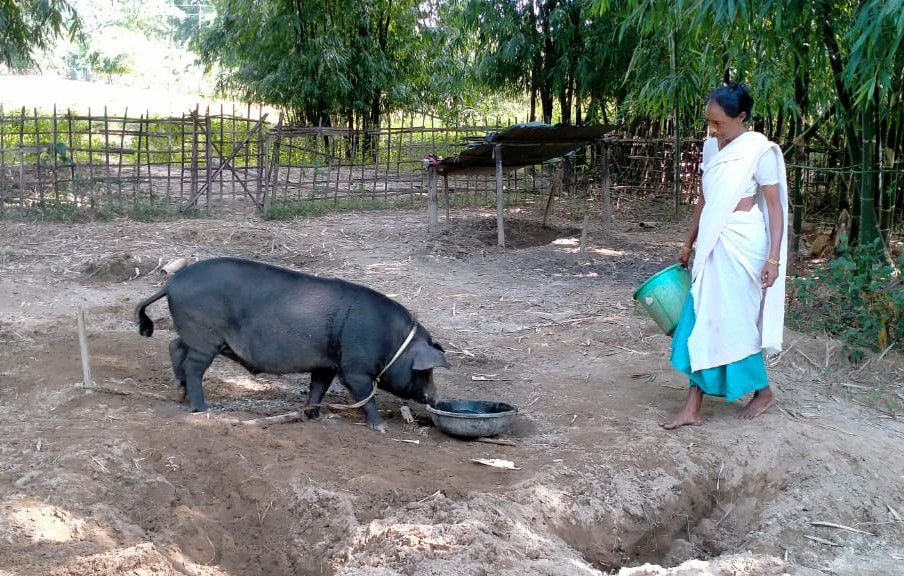ASF outbreak in Assam (Part-II): Time to stand by the woman with two pigs in her backyard
Arindom Hazarika
Post On > Aug 30 2021 1413

Over the last one-and-a-half years, the covid-19 pandemic ravaged the world economy. Tucked in one corner of India’s vast geography; Assam and northeast India had an additional concern- the first-ever outbreak of African Swine Fever (ASF). The region consumes roughly 80 percent of pig meat or pork produced in India, and pig farming is a common rural household activity.
In early 2020, unusual pig mortality was reported from Dhemaji, Biswanath, Lakhimpur, Sivasagar, Jorhat and Dibrugarh districts of Assam; and West Kameng, Papumpare, Lower Siang, Upper Siang, Lohit, Leparada, East Siang, Namsai and Changlang districts of Arunachal Pradesh.
Soon, ICAR-National Institute for High Security Animal Diseases (NIHSAD), Bhopal confirmed the first recorded outbreak of African Swine Fever (ASF) in India. There is no evidence that the disease is zoonotic, meaning no risk of human contamination. The destruction is limited to loss of livelihood and income.
Overnight all inter-state and inter-district movement of animals stopped, and most locations had bans on the sale of pork. Some northeastern States even considered transit of pigs, sourced from other parts of India, through Assam as unsafe. Farmers, small and large, processors, transporters and traders all were affected.
In a two-part series, Arindom Hazarika, a prominent food entrepreneur in Assam, elaborates the devastating impact of the outbreak on Assam’s rural economy, particularly on the small farmers and the need for an inclusive strategy to protect the livelihood and improve the rural income.
The article covers a wide range of issues starting from economy to environment, market access, sustainability of demand, productivity etc; to outline areas that need institutional interventions. The core argument being, the region must regard its traditional knowledge in pig farming and should go back to the drawing board to strengthen the model.
ASF, the author argues, is a major challenge. But the bigger challenge is to make the local economy more sustainable. The women farmers with an average of two pigs, who live on without any subsidy or support from the government, hold the key towards a better future.
Anecdotal evidence points towards multiple possible sources of the outbreak, but now that it is here in the region, our focus needs to be on the future.
African Swine Fever (ASF)virus is extremely hardy and survives on tissue, frozen meat, farm equipment and natural media in both cold and warm weather, remaining viable for weeks, sometimes months under the right conditions. The virus is not going away on its own.
The disease also brought to the fore another dimension of the ecosystem, a sort of unspoken gulf between small and large farmers.
The haves and have nots. There is a large majority of nameless, faceless and voiceless farmers, relegated to the back of the queue as unscientific backyard farmers. They receive the short end of the stick whenever there is talk of assistance or compensation.
Then we have the educated, well-spoken modern pig farmers who are vocal and visible. Some of the worst affected were these bigger farmers. Despite having comparatively better biosecurity measures, they lost their animals.
A section of stakeholders finds it easy to place blame on the smallholders for AFS spread. This is unjustified. These small (woman) farmers have one or two pigs at the most and their area of influence is limited to their backyard.
The district to district, state to state and country to country transmission happens due to human interventions beyond the reach of these small farmers. Scavenging is a detrimental practice and is on the decline. There is no space for the same, even in the case of smallholders.
The farming practices of smallholders remained the same for ages. They eke out supplementary income for the household almost without any support from the State machinery. But, this time they need support.
Thousands of small farmers have lost their pigs over the last 15 months. There is no working system to compensate for animals that weren’t culled by the state. A few advanced farmers who have received compensation have worked closely with the department to identify and effect culling of diseased or exposed animals.
The system works, just that in its current form it is not inclusive enough. Small farmers do not have the connection. They cannot complete the paperwork required to ensure a swift response from the state. For them, it is usually too late. They lose their savings and insurance overnight.
Industrial farming is no panacea
Without a system that caters to all, smallholders will keep losing their animals and eventually their hope. Many have lost their farms. A year more of uncertainty may force many small farmers to move away from piggery.
Quintessential small farms use conventional feed, reuse farm waste and are women-owned. They are happy for the occasional gift of piglet or feed packet from the government but are self-sufficient. They do not want a feed or capital grant subsidies and can be called sustainable.
Yes, small farmers need to improve on breeding practices and arguably the aesthetics of their farms. However, I would put my neck out to say that a muddy looking village farm in remote Dima Hasao is effectively cleaner than a modern farm with 500 animals in Kamrup metro. The natural microbiome in the small farm is well established and provides natural waste treatment.
The world over, many countries are moving away from the highly industrialised, concentrated piggery mega farm complexes for issues about effluent, animal welfare, superbug and environmental concerns.
Circularity in production, localised feed production and space for pigs are the buzzwords for sustainable production. Our small farmers already have these practices in play. We must build on that and must not focus on mega-farms like the west, which they are now reimagining.
The Northeast region does not have a history of producing feed crops. We have pockets of Maize but no Soyabean, thereby making any effort to produce feed locally, is an import dependent proposition. Importing (5 Kgs of) feed from Punjab and converting them to (1Kg of) pig in Assam, is counterintuitive. It is always going to be more economical to produce the pigs in Punjab and import the finished product.
Still, we see plans to make large feed mills, import feed, discuss subsidies on feed and restricting the movement of animals. With 2 million pigs, considering 30% subsidy on feed for everyone, the annual subsidy bill is an estimated 1000 crore.
Any ecosystem that is built on the restriction of movement of goods and subsidies, results in a few selected beneficiaries and limited trickle-down benefit for the masses.
The issues around piggery in Northeast India need to be looked at from a perspective that includes learnings from the west and helps heritage we already have. Our efforts should be on inclusive solutions that take into consideration all stakeholders, even the smallest farmer with one pig.
The concept of One Health which encompasses social, environmental, veterinary and economic heath needs to guide all plans for this sector. We should look at the west for sustainable technologies. Creating feed from farm excess, alternative protein sources, traceability and early detection of diseases; but not ape their commercial models, which are already 2-3 generations old.
Services for all farmers must be available on time and, we must define service delivery timelines. Traceability and GIS systems must become commonplace. We need to involve local entrepreneurs and scientists with field knowledge in the region. People who have worked with indigenous animals and farmers.
Biosecurity SOPs (standard operating practice) must be designed in a manner so that it is adaptable by the biggest and the smallest farmers.
Don't kill the market
Far too often, we tend to be swayed by international consultants with experience in multiple countries, promising sweeping reforms in the region. Sweeps and mops only come in handy when there is rubbish on the ground. Here we have traditional knowledge of sustainable farming practices.
We cannot afford to look at high capital expenditure, long gestation projects that increase production costs for pigs even further. For every new suggestion, we must ask ourselves, is this adding Rs 5 to the final product?
Today, you buy a kilo of pork in
- Guwahati for Rs 400, Itanagar Rs 500, Agartala Rs 420
- Delhi, Mumbai, Panjim (Rs 280-320)
- USA (Tesco) Rs 400, UK (Morrisons) Rs 250
The retail customer in the northeast is paying the highest price for pork in India, and possibly in the world. Prices have escalated 75% over the last few years and are pegged with the high production costs of local producers. Producers in Punjab and UP are growing pigs at a fraction of the cost of their counterparts in northeast India.
The retail market cannot support prices much beyond these levels. If we are not careful, the consumption will crash and with it the livelihood of lakhs of small farmers. Small farmers will still raise pigs for ceremonies but not for the market.
If the market cannot support the production costs locally, all pigs will come in from cheaper growing regions of India. Now we send out Rs 7000 crore a year. We might end up sending Rs 12000 cr a year to import pigs. The traders will rejoice while our farmers will cry.
Localised solutions needed
ASF is only one of the threats, it's visible, we can blame it. What about the others we have festered over decades and still struggle to find answers to? Basic feed and vaccine sufficiency for all our pigs? Cold chain and basic meat retail hygiene for customers who pay international prices?
States outside of the Northeast have mastered efficient production systems in the last 10 years. Not because they used western models or invested in consultants, they leveraged what they have (cereals and grains, vegetable wastes, recycled IT Industry food waste, recycled hostel waste).
The solution lies within the state, within us. We must look at integrated solutions, keeping everyone in mind. Localise solutions using the best options from around the world.
The woman with 2 pigs who has sustained for the last 200 years knows how to run her business, best we can do is to learn from her and adopt our learnings to help her. Not tell her what she is doing wrong.
Her children’s education depends on those two pigs, she has more riding on those animals than most of us trying to make decisions for her. She will accept changes if it makes sense to her, not to us.
**Arindom Hazarika is a co-founder of Arohan Foods, which is working in the value chain, food processing, sustainable technology and rural livestock space for the last 10 years.**
Disclaimer: Views expressed in the content belong to the author.
ASF outbreak in Assam (Part-I): $2 bn market hit, small farmers hit the hardest

Northeast Energy Scenario Part-1: Paradigm shift in petroproduct availability and consumption
2023-03-28 16:22:05

Consolidation of 'indigenous' votes aligned Tripura's political landscape with the rest of the northeast.
2023-02-16 08:51:53

Why Kolkata doesn’t have a Unicorn ?
2023-01-28 09:53:57

Social media literacy should be mandatory in UG curriculum
2022-11-30 12:00:53

India's new CDS, Gen Anil Chauhan has a daunting task ahead!
2022-09-30 10:34:59

Make annual BBIN summits a norm, create a common market for food and services
2022-08-13 10:39:02
